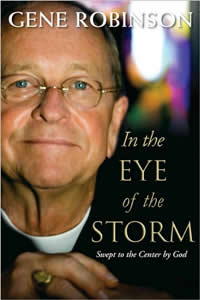Book Notes
 Gene Robinson, In the Eye of the Storm; Swept to the Center By God (New York: Seabury Books, 2008), 176pp.
Gene Robinson, In the Eye of the Storm; Swept to the Center By God (New York: Seabury Books, 2008), 176pp.
When the openly gay priest Gene Robinson consented to his election as the ninth Anglican bishop of the Diocese of New Hampshire in 2003, he chose to become both the lightening rod and the standard bearer of the most controversial issue in Christianity today. That's why he wore a bullet-proof vest at the ceremony and why bomb-sniffing dogs cleared the building. Never again will he be just another bishop or a mere private citizen, despite his complaints about being labeled a single-issue priest. He knows that he will "never again be in a 'small room.' Because of the high level of media attention, followed by the close scrutiny of those who oppose me, I'm never in a trusting, safe environment where I can let my guard down. Someone is always watching and will use anything I say against me" (46).
Whether by Robinson's choice or unfortunate necessity, in this book you learn precious little of the personal from this very public figure. He does mention in passing his roots in a poor, uneducated, and deeply Christian family in rural Kentucky where his parents were tenant farmers; his first marriage by which he had two children; his treatment for alcohol dependence; and his twenty-year commitment with his current partner Mark Andrews. But all these are brief mentions. True to his word, he never lets his guard down. If you want to learn more about Gene Robinson the man you'll do better starting at the Wikipedia article. Perhaps my expectations before reading this book were misplaced, but in my own experience the power of personal story far surpasses the tedium of theological wrangling. I wanted to learn more about Gene Robinson's personal story.
The twenty-three short chapters in 175 pages treat a broad panoply of Christian themes, many of which read more like unedited sermons than successive chapters in a book. For example, a chapter on the Good Samaritan is followed by a four-page chapter on why for Christians "religion and politics must mix," which is followed by an anecdotal chapter about a trip to Hong Kong. Even when he speaks about gays in the church the treatment is so short for such complex issues that I found it frustrating. Just what, for example, are the implications pro and con of separating the civil rights of marriage by the state and the Christian rites of blessing a marriage by the church?
This book and Robinson's many public interviews about it were timed to coincide with and maximize exposure of the global Anglican church's summer 2008 Lambeth Conference that gathers all its bishops every ten years — and from which Robinson has been excluded as an official participant but invited in a "diminished status" (168); and his decision to marry his partner Mark Andrews in a June 2008 civil union that will then be blessed in his church. That's not a bad thing for a person who's leading an important cause. But this book will attract readers more because of who wrote it than what he says. In my own reflections of Christian gays I was more deeply influenced by Mel White's Stranger at the Gate; To Be Gay and Christian in America (New York: Plume, 1994); Carol Curoe and Robert Curoe, Are There Closets in Heaven? A Catholic Father and a Lesbian Daughter Share Their Story (Minneapolis: Syren Book Company, 2007); and then the documentary film For the Bible Tells Me So (2007) about five Christian families whose gay children went public — one of whom is none other than Gene Robinson.


